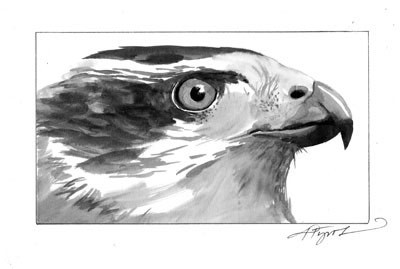
Keeping chickens at the edge of a forest is always a gamble. Foxes, raccoons, skunks, weasels, fishers, and coyotes can sally forth at any time from the shadows of the woods in search of a chicken supper. So far my chickens, in their 40 by 40-foot electrified pen, have been spared from land-based assaults, but attacks also can come from the sky.
Summer weather allowed a canopy of weeds to grow tall over our chickens – despite their attempts to scratch everything up – but that cover is now long gone. I had thought, optimistically as it turns out, that the loss of this camouflage would coincide, more or less, with fall’s southern migration of hawks. I had guessed there would be little likelihood of an aerial attack in winter.
But late one afternoon last month, we arrived home to find that our rooster was missing. Our half-dozen hens, a mixed bunch of Rhode Island Reds and Wyandottes, were cowering in the small space beneath the chicken house. We found the partly eaten rooster carcass still in the pen, under an inch or two of fresh snow that had obliterated any tracks or signs of a struggle. I removed the dead bird and retired for the night, wondering what predator had struck.
Morning revealed the culprit. Sitting on a low stump inside the pen and eyeing the chicken house was a large hawk. Its tracks in the snow showed where it had landed in search of the rooster leftovers that it evidently had planned for breakfast. I grabbed my camera and snapped its ‘mug shot,’ capturing its prominent white ‘eyebrows,’ dark cap, and body coloration that perfectly matched a photograph in the bird guide. The suspect was a northern goshawk, a big bird, about the size of a red-tailed hawk, with dark gray plumage and an off-white breast. When it flew off, it flashed the characteristically bright white plumage beneath its tail.
This raptor is an uncommon, if not rare, species across the northern United States. It favors northern boreal forests in the eastern part of its range and has a year-round presence in Vermont and New Hampshire. It is the largest and, by all accounts, most aggressive hunter in the group of hawks known as accipiters. These hawks do not soar and then plunge from above; they are adapted to hunt in forests, where they move stealthily from perch to perch, stalking prey among the trees and brush. When they spot something, they attack swiftly, almost horizontally.
Goshawks are equipped with wide, powerful wings and long tails for sharp maneuvering through the woods. Their acceleration from a standing start is stunning. Bold and persistent, they dive into thick brush in pursuit of squirrels, snowshoe hares, ruffed grouse, crows, woodpeckers, and large songbirds, such as the American robin. And of course, chickens. Goshawks have been known to barrel into barns after chickens or snatch them at the very feet of their keepers.
Apart from these incidents, goshawks are seldom seen or heard. They are most likely to reveal themselves in breeding season, when both males and females give calls that sound somewhat like the noises made by seagulls. In New England they nest in the interiors of extensive, mature forests on moderate slopes with an open understory. They prefer sites near water, and they usually give human presence a wide berth. The goshawk’s hallmark ferocity extends to protection of its nest, so it will attempt to drive off intruders, including people, with talon-wielding charges.
The goshawk does have a long association with humans, who centuries ago found ways to exploit this hawk’s hunting prowess. As early as the third century A.D., goshawks were tamed and used in the sport of falconry in China and Japan. In the West, goshawks were used in falconry by mid-eastern and Germanic tribes; the goshawk was so revered, in fact, that Attila the Hun adorned his helmet with the bird’s image. Later, in medieval Europe, the goshawk was prized as ‘the cooks’ hawk,’ a reliable provider of meat for the table. But with the introduction of firearms and the decline of falconry, goshawks eventually became targeted as poultry thieves. In the United States, goshawks and other raptors finally gained federal protection in 1972, so it is now illegal to possess or kill them.
The goshawk that claimed our rooster has not returned, thankfully. Perhaps it was a migrant moving southward just as we were moving deeper into winter. We missed our rooster, but where we live, I accept predation as part of the natural order. At least our rooster was taken not by some common predator but by this formidable king of the forest.

